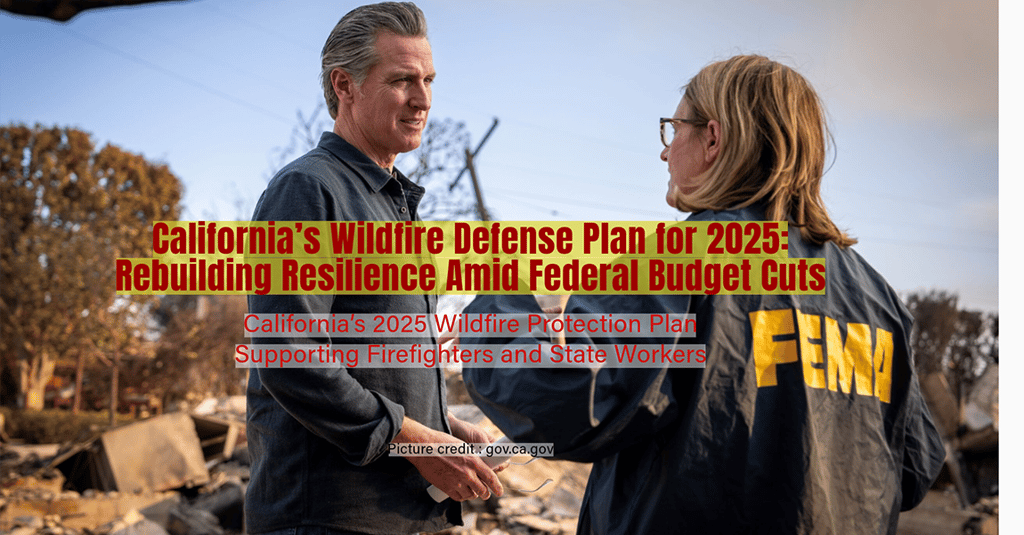California’s Wildfire Defense Plan for 2025: Rebuilding Resilience Amid Federal Budget Cuts
4/22/20253 min read


California’s Wildfire Defense Plan for 2025: Rebuilding Resilience Amid Federal Budget Cuts
One hundred days after the devastating Eaton and Palisades fires, which claimed lives, destroyed over 10,000 structures, and scorched 38,000 acres, California stands united in recovery and resilience. As summer looms, the state is gearing up to protect communities from the next wildfire season. Governor Gavin Newsom’s administration has rolled out an ambitious wildfire protection plan for 2025, but federal budget cuts threaten to strain the heroic firefighters and state workers who safeguard Californians. This post explores California’s strategy, the impact of U.S. budget reductions, and the lessons learned from recent fires that are shaping a stronger, community-driven defense.
California’s 2025 Wildfire Protection Plan
California’s wildfire strategy, bolstered by a $2.5 billion investment since 2020 and an additional $1.5 billion from the 2024 Climate Bond, focuses on prevention, response, and community resilience. Key components include:
More Firefighters, Better Conditions: CAL FIRE’s workforce has nearly doubled since 2019, growing from 5,829 to 10,741 personnel. The 2025-26 budget proposes $89.7 million annually to add 350 firefighters and implement shorter 66-hour workweeks to improve well-being.
World’s Largest Aerial Fleet: The state has expanded its aerial firefighting capacity with 16 new helicopters, seven C-130 air tankers, and 24 contracted aircraft, many equipped for night operations.
Advanced Technology: Investments of $37.1 million annually support AI-powered fire detection, satellite mapping, and the Fire Integrated Real-Time Intelligence System (FIRIS) for real-time wildfire tracking.
Community Hardening: New “Zone 0” regulations mandate ember-resistant zones within five feet of structures in high-risk areas. A pilot program aids vulnerable homeowners with fireproofing, with $9 million proposed to expand it.
Forest Management: $170 million was approved in April 2025 to thin overgrown forests, reducing fuel loads. Since 2021, 61 fuel reduction projects near the Eaton and Palisades fire zones have treated 14,500 acres.
These efforts aim to make California’s communities fire-ready, but success hinges on the state’s ability to execute amid fiscal challenges.
Federal Budget Cuts: A Blow to Firefighters
The U.S. Department of Government Efficiency (DOGE), led by Elon Musk, has slashed federal spending by $1 trillion, including funds for wildfire response. While specific cuts to California’s federal firefighting aid are unclear, the impact is already felt:
Reduced Federal Support: The Federal Emergency Management Agency (FEMA) and Department of Defense typically provide manpower, equipment, and debris removal funding. DOGE’s cuts could limit these resources, forcing California to shoulder more costs.
Strain on Local Fire Departments: Los Angeles Fire Department (LAFD) Chief Kristin Crowley warned that local budget cuts of $17.6 million in 2024-25, compounded by federal reductions, hampered emergency response. Overtime cuts and the loss of 58 positions reduced training and brush clearance efforts.
Mutual Aid Challenges: California relies on federal mutual aid for large-scale fires. DOGE’s restructuring may delay or reduce out-of-state firefighter deployments, as seen when five states aided the Palisades response.
Firefighters, already battling year-round blazes, face increased workloads and burnout risks. California’s plan to add personnel and improve conditions is a step forward, but federal cuts could undermine preparedness.
Lessons from the Eaton and Palisades Fires
The Eaton and Palisades fires, fueled by 100-mph Santa Ana winds and drought-parched vegetation, exposed vulnerabilities and galvanized action:
Water Supply Failures: Dry hydrants and an offline Santa Ynez Reservoir in Pacific Palisades forced firefighters to improvise. Governor Newsom ordered an investigation, and new protocols ensure reservoirs remain operational during fire season.
Urban Fire Risks: The fires’ urban spread—destroying affluent and working-class homes alike—highlighted the need for “home hardening” like ember-resistant vents and defensible spaces. Community education on these measures is now a priority.
Climate-Driven Extremes: With 78 more “fire days” annually than 50 years ago, California’s year-round wildfire season demands proactive forest management and power shutoff strategies to prevent utility-sparked blazes.
Community Action: Residents rallied post-fire, organizing debris cleanup and supporting evacuees. Grassroots efforts, like Airbnb’s free housing for evacuees, inspired state programs to fund community-led resilience projects.
These lessons are shaping policies like Zone 0 and expanded fuel reduction, empowering Californians to protect their homes and neighbors.
Supporting Firefighters and State Workers
Firefighters and state workers are the backbone of California’s wildfire defense. The state’s shorter workweeks and $449 million for 75 new fire crews signal strong support. Community gratitude is evident in initiatives like the California Rises 2025 Grant, which funds local fire departments for recovery efforts. Yet, federal cuts and local budget constraints, like LAFD’s $7 million overtime reduction, underscore the need for sustained investment. Californians can advocate for firefighters by supporting bond measures and volunteering for fuel reduction projects.
Conclusion
One hundred days after the Eaton and Palisades fires, California’s 2025 wildfire plan blends cutting-edge technology, robust firefighting forces, and community resilience. Federal budget cuts pose challenges, but the state’s commitment to its firefighters and lessons from past fires offer hope. By uniting government, residents, and first responders, California aims to not just rebuild but rise stronger, ready for the next blaze.
Thought Questions:
How can Californians balance federal budget cuts with local wildfire preparedness needs?
Are community-driven initiatives like home hardening enough to combat year-round wildfires?
What more can residents do to support firefighters and state workers beyond funding?
hello@boncopia.com
+13286036419
© 2025. All rights reserved.